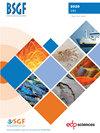Bedforms in a tidally modulated ridge and runnel shoreface (Berck-Plage; North France): implications for the geological record
IF 2.6
3区 地球科学
Q2 GEOSCIENCES, MULTIDISCIPLINARY
引用次数: 10
Abstract
Tidally modulated shoreface (TMS) corresponds to peculiar costal environments. The general morphology and the expressed bedforms are provided by the interplay of both waves and tides. The recognition of TMS in the fossil record still remains a difficult task. The study of one mega-tidal modern TMS in the north of France (Berck-Plage) provides new key criteria to identify this kind of coastal system in the rock record. Field investigation and digital mapping were realized at lowest tide during spring tide under fair-weather condition. The intertidal zone is characterized by a succession of several sand banks shore parallel separated by topographic lows that are defined as ridges and runnels. Seven distinct dominant bedforms are recognized: 3D current ripples, 3D asymmetrical ripples, 2D symmetrical ripples, 2D small symmetrical dunes, 2D large symmetrical dunes, 3D symmetrical dunes and plane beds. The upper stage plane bedding mainly composed the ridges while the six other bedforms are commonly found within the runnels or on the flanks of the ridges. Comparison of the bedforms of Berck-Plage with previous experimental studies on bedforms genesis proves that the necessary flow parameters for generating these bedforms belong to an oscillatory flow except for the 3D current ripples, which are formed by a unidirectional flow. This study confirms the dominance of oscillatory structures through the intertidal zone in a mega-tidal context and show that wave processes are more powerful than tide processes for bedform generation although during fair weather conditions. Based on the timing of genesis, the description and the repeated pattern of distribution of bedforms between two ridges is highlighted thus helping to propose a theoretical facies sequence for an intertidal zone characterized by ridges and runnels applicable to ancient sedimentary successions.潮汐调制脊状和流状海岸面(伯克-平原)的地形;北法国):对地质记录的影响
潮汐调制海岸面(TMS)对应于特殊的海岸环境。波浪和潮汐的相互作用提供了一般形态和表达的层状。在化石记录中识别经颅磁刺激仍然是一项艰巨的任务。对法国北部一次巨型潮汐现代TMS (Berck-Plage)的研究为在岩石记录中识别这类海岸系统提供了新的关键标准。在天气晴朗的情况下,在春潮低潮时进行实地调查和数字制图。潮间带的特点是一连串的沙滩,海岸平行,由地形低洼分隔,被定义为山脊和河道。识别出七种不同的主要河床形态:三维水流波纹、三维不对称波纹、二维对称波纹、二维小对称沙丘、二维大对称沙丘、三维对称沙丘和平面床。上段平面层理主要由隆起组成,其他6种层理一般分布在流槽内或隆起两侧。将Berck-Plage的床型与以往床型形成的实验研究进行对比,发现除了单向流形成的三维流纹外,形成这些床型所需的流动参数都属于振荡流动。这项研究证实了在大潮汐背景下振荡结构在潮间带中的主导地位,并表明波浪过程比潮汐过程更强大,尽管在良好的天气条件下形成河床。在成因时间的基础上,强调了两脊间层状体的描述和重复分布模式,从而提出了适用于古沉积序列的以脊流为特征的潮间带理论相序列。
本文章由计算机程序翻译,如有差异,请以英文原文为准。
求助全文
约1分钟内获得全文
求助全文
来源期刊
CiteScore
5.80
自引率
0.00%
发文量
18
审稿时长
>12 weeks
期刊介绍:
BSGF - Earth Sciences Bulletin publie plusieurs types de contributions :
1. des articles originaux, couvrant tous les champs disciplinaires des Géosciences, à vocation fondamentale mais également à vocation plus appliquée (risques, ressources);
2. des articles de synthèse, faisant le point sur les avancées dans un domaine spécifique des Géosciences, qu''elles soient méthodologiques ou régionales ;
3. des monographies sur la géologie d’une région donnée, assorties d’informations supplémentaires, cartes, coupes, logs, profils sismiques … publiées en ligne en annexe de l’article ;
4. des articles courts de type « express letter » ;
5. des livrets-guides d’excursion (qui suivront le même processus d’examen éditorial que les articles plus classiques) ;
6. des comptes rendus de campagnes à la mer ;
7. des articles de données géodésiques, géophysiques ou géochimiques, pouvant devenir des articles de référence pouvant conduire à des interprétations ultérieures.
BSGF - Earth Sciences Bulletin constitue également un forum pour les discussions entre spécialistes des Sciences de la Terre, de type comment-reply ou autre. Tous les articles publiés, quelle que soit leur forme, seront accessibles sans frais (articles en Open Access) sur le site de la SGF et sur celui de Geosciences World dans la mesure où les auteurs se seront acquittés d’une contribution de (Article Processing Charges – APC) de 300€ pour les membres de la SGF et 500€ pour les non-membres.

 求助内容:
求助内容: 应助结果提醒方式:
应助结果提醒方式:


